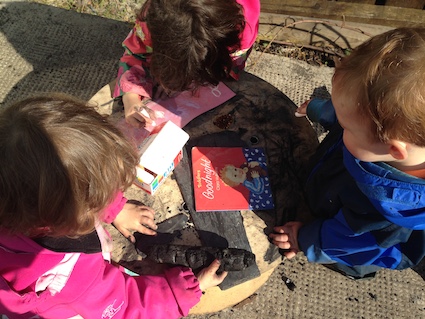
Writing outside is becoming increasingly popular in many primary and secondary schools as a method of engaging children and providing activities and stimuli which cannot be found indoors. The multi-sensory nature of much outdoor learning helps children to retain ideas and feelings that can be communicated through writing. The changing events, seasons and incidents adds richness to the experience. Furthermore there are lots of places to write and mediums to use. Variety is the spice of life!
The possibilities for extending writing outside are limitless. To get your creative juices flowing, it can help to brainstorm ideas with children and colleagues.
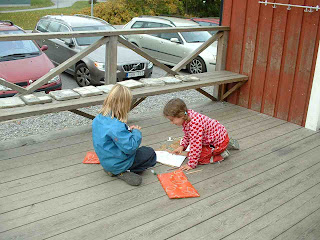
Authors and poets often write outside. There is documented evidence of William Wordsworth walking the Lakeland fells with his sister, Dorothy, at his side scribbling down his ideas and thoughts. More recently, Ian Hamilton Findlay created Little Sparta, his greatest work of art, where poetry and sculpture are fused with the natural landscape. Here many ideas can be explored which can enrich features of school grounds for literary purposes.
Writing activities outdoors can have several aims:
- To learn or reinforce specific skills, knowledge and understanding
- As a context for activities where the surroundings act as a stimulus
- To build vocabulary and knowledge about the world
- As a springboard to indoor work
Advice about writing outside
When it comes to resources for writing outside, very little is required.
1. Use pencils at all ages and stages
Unlike pens, pencils will write on paper and card that is damp or wet. Take lots of spare pencils outside as the tips do break and they can get mislaid. You don’t want to waste time searching for pencils or waiting for children to take turns to sharpen their pencils. Don’t bother with erasers.
2. Think about the size of clipboards
Children enjoy using a variety of clipboard sizes. A5 clipboards are great for small work such as secret messages and poems written by individual children. A3 clipboards allow for a bigger writing experience. Children who have motor difficulties often find these bigger clipboards easier as elbows can be used to balance and steady the writing surface.

3. Use scrap pieces of card and paper
On windy days, using scrap pieces of card is easier because there is less flutter. The card or paper can also be stuck onto clipboards with masking tape too. Alternatively, cut A4 paper which has already been used on one side into quarters. Put into stacks of 10 sheets and staple in one corner. These little notebooks are more portable and useful outside than big A4 sheets.
4. Think about using the outdoor environment as a writing surface
A beach is one giant interactive writing board. Sand can be used for making 3-D letters as well as writing into the sand itself. Grit and mud also work well. Use sticks or fingers to scratch words into soil, mud, grit or forest floor litter. Look at opportunities for having different surfaces that can be used for writing. Why bother with pencils, card and clipboards when you don’t have to!
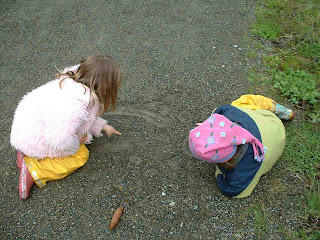
5. Use other portable writing surfaces
Whiteboard markers can be used outside with portable old whiteboards (new ones will get scratched more quickly outside). In addition to these, mirrors, unwanted CDs and varnished wooden slabs all make great writing surfaces for non-permanent marker pens.
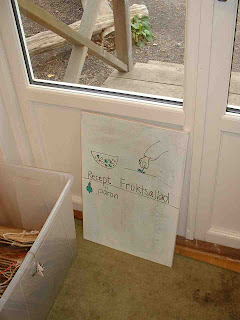
6. Make the most of your tablets, iPads and other digital devices
If your establishment has tablets or iPads or other mobile devices that children can use, then there are many apps that can be downloaded and used for writing outside. Use digital cameras to record transient work which can be left for others to enjoy.
7. Have portable mats
To be comfortable outside, portable mats make a noticeable difference. Any surface can be sat upon in all weathers and the insulation provides extra warmth. Ones which can be folded up and carried in a backpack are particularly handy. For lots of ideas and advice about portable seats, have a look at these blog posts.
8. Vary your activities at different times of the year
Writing works well all year round. Some of the best poetry I have seen has come from children creating poems outside on a cold day with temperatures below zero. The trick is to remember to keep children moving about. Trails and word hunts work well in colder weather.

9. Re-tell or read aloud children’s writing outside
Poetry is meant to be spoken aloud. Stories and other forms of writing shared outside foster a collaborative sense of achievement.
Making your outdoor area writing-friendly
If your school or setting is considering improving its grounds, then here’s some ideas for encouraging children to write outside through the use of specific features.
1. Do not confine writing activities to one part of the grounds
Traditional seating and tables make a lovely place to write, but this sends the message that we only write at a table when sitting on a chair. Yet the reality is that people write in different ways in many different places. Use the portable seats and writing material listed above and work where it most suits the lesson you are undertaking.
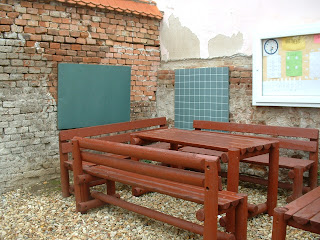
2. Provide places on walls where children can write and draw
On the walls, have places where children can write and draw. These can be black boards or white boards. Noticeboards are useful too where children can post their own messages and announcements. Mirrors also make good drawing and writing surfaces outside, as does Perspex. Generally the bigger the writing space, the more flexibly it can be used.
3. Performance spaces or decking are useful for writing
As adults we will text, use phones or tablets whilst having a picnic in a park, or take notes as we lie around. Such spaces are useful gathering places. Often a whole class can fit on a decked area. It is a cheaper solution than buying lots of outdoor seating. Below is an example of a decked area surrounding a tree that was created by a local joiner.
4. Consult children about etching words and phrases into fixed structures
For example, a friendship bench may have words of friendship in different languages painted on or chiselled into the wood. Etchings can be used for taking rubbings using waxed crayons and paper.

5. Put in features which are open-ended and have multiple uses
In the photo below, the wooden stumps and border of the sandpit can be used for mark making. Children can chalk or paint directly onto these surfaces. Alternatively children can seat on these features to write. Or, by sitting on the ground, the stumps and border can be used as mini tables.
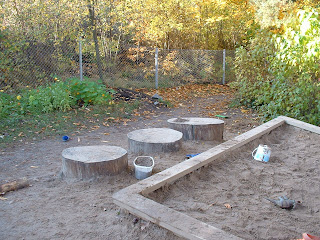
6. Make outdoor displays really attractive
Whatever work is displayed outside, ensure it is fit for purpose and relevant to the area where it has been put. Have an agreement amongst staff that any class which puts up a display outside has a responsibility to maintain it too. After all, you wouldn’t put up a nice display in your own classroom or nearby corridor and then let it get worn and wonder who will get round to changing it!
If you have to laminate material to go outside, put duct tape in the corners as reinforcements for hole punches. Soft anodized wire works well for attaching to fences. Types of display may include:
- Information displays, e.g. about your wildlife garden.
- Signs and advice written by children
- Just like indoors, the displays can be children’s stories, poems or other forms of writing
- Cross-curricular project work
- Three dimensional displays such as sculpture or artwork which include language.
7. Think about shelter
Shelters can be handy during inclement weather. I’ve blogged about temporary shelters and permanent ones If your school is in a windy place, then have walls or fences as part of the structure to reduce airflow. Try to avoid a dark shelter where it is difficult to see and where views are limited. A Perspex roof and windows can help. Erecting a shelter where parents who are collecting their children can gather makes the space even more versatile.
8. Nooks, crannies and scattered seats
Some children like writing in small groups. Look at creating secluded areas where children have space to be alone to write. By careful pruning, it is still possible to maintain a degree of visibility for supervising staff.
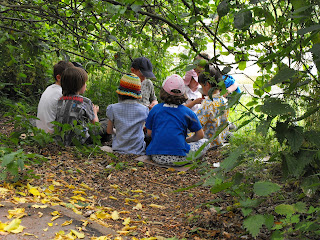
9. Develop different habitats
These can be used for comparative work. The greater the variety of trees, shrubs, flowers and surfaces, etc., the greater the opportunity for developing knowledge and understanding. For example, having long and short grass growing works well for exploring the different senses, plants and minibeasts that will live in each place. These habitats are springboards for writing.

Finally, consider how features that enable writing outdoors impact on the ethos of your school or setting. For example, if your school aims include maximising learning opportunities for children, have a think about how this works outdoors. Often entrances to schools can be improved through the creative use of text. Have a look at this beautiful wishing wall as an example.




















One of my favorite places in the world to write is outside. Thanks for all the useful tips & suggestions for making it comfortable for kids.
Thanks for all the good ideas!
Great ideas. Like you, we also love to be outside to do our writing. We generally have nice weather that makes it possible for us to get outside mush of the time.
Love the gazebo / covered chair thing you have in the one photo, too. very nice…wish we had one of those here.
Have a happy week,
Colleen:)
Hi, I did notice that some of the pics were taken in Sweden, do you happen to have for sharing info on specific schools in Sweden? Especially, if those are near Stockholm city. Thanks!
Hi Liga
Thanks for dropping by – Yes 2 photos are from Sweden – if you get in touch via email which is at the bottom of every page in my website, I’ll forward details to you. https://www.creativestarlearning.co.uk
Thank you so much for all your inspiration. I loved the Cowgate under 5’s link. I wondered if it is possible to find out where they sourced a number of their resources e.g the drums?
Thank you for your inspiration! I wondered if you knew where Cowgate Under 5’s sourced some of their resources? E.g. the drums outdoors?
Nicola
I think most of the instruments came from RM http://www.rm.com/shops/rmshop/Product.aspx?cref=PD1605967
Hope this helps
Juliet